
La Earhcache / The Earhcache
► Contexte géologique local
La pointe de Beg-Meil est incluse dans une vaste socle crustal, la formation de Tregunc.
Si la majeure partie de cette formation est un granite, des enclaves d'orthogneiss y apparaissent.
Pour ces deux roches, la texture grenue grossière et la composition chimique sont identiques (roches QFM : Quartz/Feldspath/Mica), donnant une roche à teinte claire.
La différence entre les deux tient à la disposition des cristaux les uns par rapport aux autres :
- Le granite est une roche NON litée, les cristaux n'ayant aucune orientation particulière.
- L'orthogneiss est une roche litée. Les minéraux sont orientés, donnant un aspect finement folié.
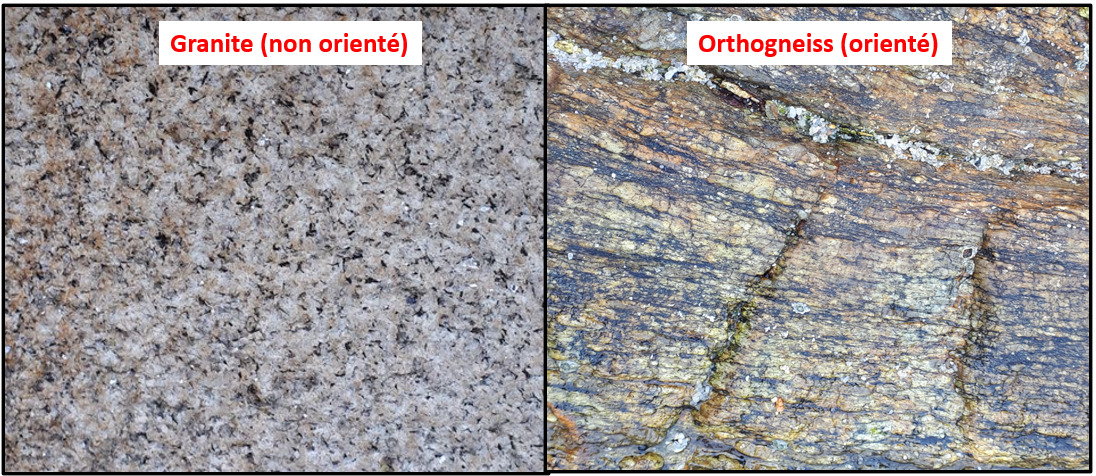
► La dolérite, une roche intrusive
Il est possible d'observer dans cette formation de Tregunc des filons de dolérite.
Cette roche magmatique très finement grenue est sombre (noire ou bleue sombre).
Elle se met en place à la faveur de cassures dans la roche existante.
Dans le cadre d'un encaissant lité (orthogneiss), ces cassures vont naturellement emprunter l'axe des lits, ce qui ne sera pas le cas dans des roches non litées comme le granite.
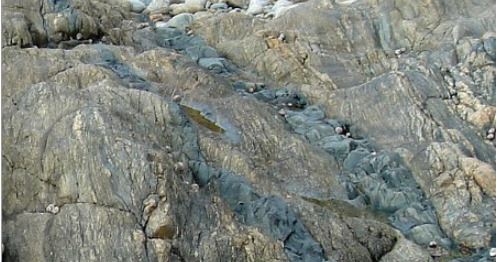
► Failles, filons et rejet
Des mouvements de compression affectant une roche très rigide comme le granite entrainent des fractures permettant à un jus magmatique résiduel silicatée de s'infiltrer puis de cristalliser, donnant des filons d'une roche blanche dure, la pegmatite.
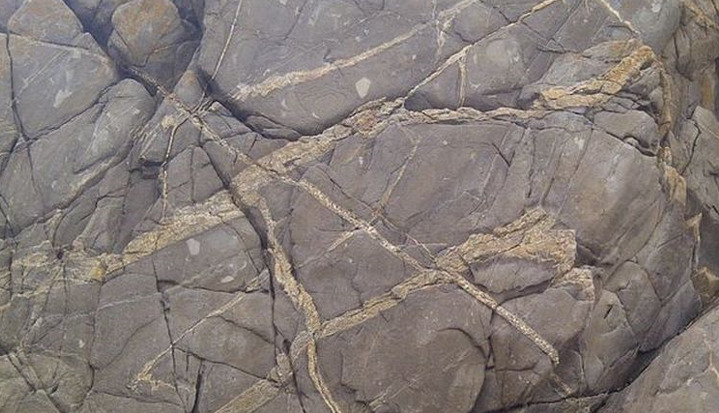
Ces filons donnent des repères d'orientation mettant en évidence des mouvements de compression.
Ainsi, on observe des failles avec un déplacement relatif des compartiments dans ces filons.
Une des composantes d'une faille, le rejet, correspond à la mesure du décalage qui s’est produit entre les deux compartiments séparés.
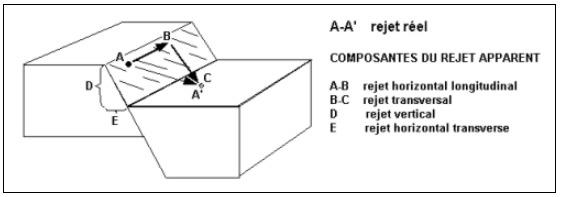
► Principes de datation géologique
Il existe plusieurs type de datation relative des roches et événements géologiques.
L'un d'entre eux est le principe de recoupement : Un événement (intrusion magmatique, faille, plissement, discordance, érosion) qui provoque un changement dans la géométrie des roches est postérieur à la dernière strate qu'il affecte et antérieur à la première strate non affectée.
Autrement dit, tout événement géologique qui en recoupe un autre lui est postérieur. Dans l’exemple ci-dessous, le filon F est postérieur aux strates 1 et 2, mais antérieure à la strate 3.

► Local geological context
The Beg-Meil point is included in a vast crustal basement, the Tregunc formation.
If the major part of this formation is a granite, enclaves of orthogneiss appear there.
For these two rocks, the coarse grainy texture and chemical composition is identical (QFM rocks: Quartz / Feldspar / Mica), giving a light colored rock.
The difference between the two is the arrangement of the crystals in relation to each other:
- Granite is a NOT bedded rock, the crystals having no particular orientation.
- Orthogneiss is a bedded rock. The minerals are oriented, giving a finely foliated appearance.
► Dolerite, an intrusive rock
It is possible to observe veins of dolerite in this Tregunc formation.
This very finely grained igneous rock is dark (black or dark blue).
It is put in place thanks to breaks in the existing rock.
In the context of a bedded structure (orthogneiss), these breaks will naturally follow the axis of the beds, which will not be the case in un bedded rocks such as granite.
► Faults, veins and rejection
Compressive movements affecting a very rigid rock such as granite lead to fractures allowing a residual silicate magmatic juice to infiltrate and then crystallize, giving veins of a hard white rock, pegmatite.
These veins provide orientation markers highlighting compressive movements.
Thus, faults are observed with a relative displacement of the compartments in these veins.
One of the components of a fault, the rejection, is the measure of the lag that has occurred between the two separate compartments.
► Principles of geological dating
There are several types of relative dating of rocks and geological events.
One of them is the principle of overlap: An event (magmatic intrusion, fault, folding, unconformity, erosion) which causes a change in the geometry of the rocks is posterior to the last stratum that it affects and prior to the first unaffected stratum.
In other words, any geological event which intersects with another is subsequent to it. In the example below, vein F is later than strata 1 and 2, but earlier than stratum 3.
► Sources bibliographiques / Bibliographical sources
Les Questions / The Questions
Questions pour valider :"Découvertes géologiques à Beg Meil"
Questions to validate: "Geological discoveries at Beg Meil"
!!! ATTENTION CACHE UNIQUEMENT ACCESSIBLE MAREE BASSE !!!
!!! WARNING EARTHCACHE ONLY ACCESSIBLE LOW TIDE !!!
Avant de vous y aventurer, consulter l'horaire des marées :
Before you go, check the tide schedule:
Horaires des marées à Beg-meil.
- Question 0 : Prenez une photo de vous ou d'un élément vous appartenant sur la plage.
Cette photo devra au choix nous être transmise avec les réponses ou être ajoutée à votre log.
-Question 0 : Take a photo of yourself or something you own on the beach.
This photo must either be sent to us with the answers or added to your log.
Point 1 : N 47° 52.198' W 3° 59.086'
Vous voici sur l'estran. Repérez les zones à observer de la photo WP1.
Here you are on the foreshore. Locate the areas to be observed in photo WP1.
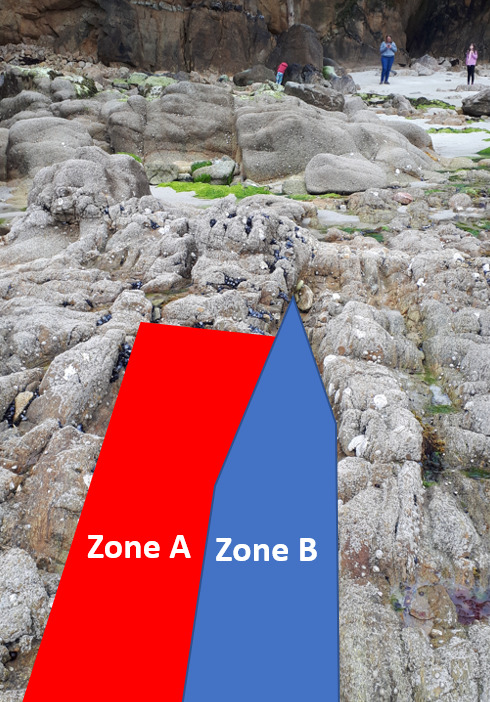
- Question 1 : Décrivez la roche bien visible sous la zone rouge A. Quelle caractéristique principale vous permet de l'identifier ?
- Question 1: Describe the clearly visible rock under the red zone A. What main feature allows you to identify it?
- Question 2 : Décrivez la roche sous la zone bleue B et identifiez la. L'axe de cette roche vous paraît-il cohérent par rapport à votre réponse à la question 1 ?
- Question 2: Describe the rock under blue area B and identify it. Does the axis of this rock appear to you to be consistent with your answer to question 1?
Point 2 : N 47° 52.191' W 3° 59.096'
Dirigez-vous maintenant vers la falaise (photo WP2).
Now head to the cliff (photo WP2).
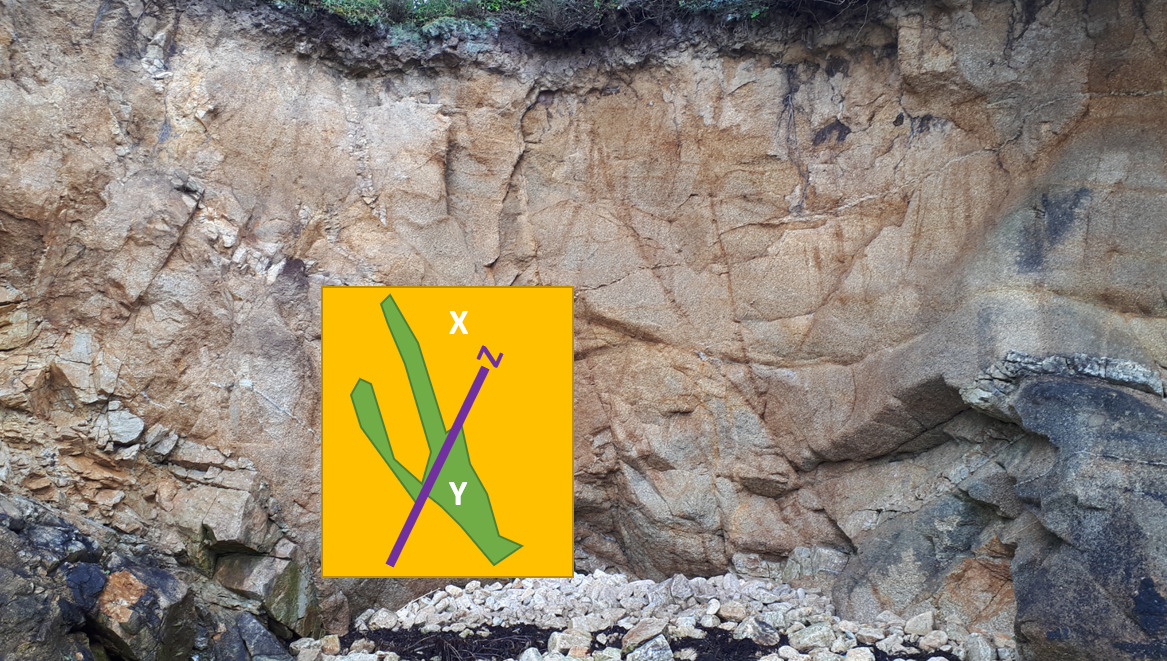
- Question 3 : Datez relativement les zones jaunes X, vertes Y et violettes Z, en expliquant votre raisonnement.
- Question 3: Relatively date the yellow X, green Y, and purple Z areas, explaining your reasoning.
- Question 4 : Mesurez le rejet mis en place par la faille Z.
- Question 4: Measure the release put in place by the Z fault.
Vous pouvez vous loguer sans attendre notre confirmation,
mais vous devez nous envoyer les réponses en même temps soit par mail via notre profil (
fafahakkai), soit via la messagerie geocaching.com (Message Center).
S'il y a des problèmes avec vos réponses nous vous en ferons part.
Les logs enregistrés sans réponse seront supprimés.
You can log this cache without waiting for our confirmation, but you must send us the answers at the same time, by e-mail via our profile (fafahakkai) or by the system of Message Center of geocaching.com.
If there is a problem with your answers we will notify you. The logs recorded without answers will be deleted.
Rappel concernant les « Earthcaches »: Il n'y a pas de conteneur à rechercher ni de logbook à renseigner. Il suffit de se rendre sur les lieux, de répondre aux questions ci-dessus et de nous renvoyer les réponses.
Reminder concerning "Earthcaches": there is neither a container to look for nor a logbook to sign. One need only go to the location, answer to the differents questions and send us the answers.